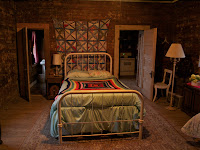Apparently
Mississippi bluesman Robert Johnson did more than sell his soul at the
Crossroads. He split it three ways, kinda like Voldemort’s horcruxes in Harry
Potter.
Johnson
has three gravesites in Mississippi.
Robert
Johnson blazed the blues trail, leaving us with some of the genre’s most
important recordings, many of which influenced later musicians and helped
developed other genres such as rock ‘n’ roll.
Legend
has it that his ambition drove him to meet the devil near Mississippi’s Dockery
Plantation, where the devil tuned his guitar and endowed him with great talent
in exchange for his soul. Today, visitors can easily find this “Crossroads” in
Clarksdale, marked by a giant sign.
Whether
this story is true, you be the judge. Robert Johnson and the “Crossroads” has
spurred numerous discussions over its origins and truth.
 |
| Robert Johnson's grave at Little Zion in Greenwood. |
The indisputable reality was that Robert
Johnston died way too young, at the age of 27 in 1938 outside Greenwood, Miss.
Where he’s buried is another mystery.
The
three gravesites of Robert Johnson in Mississippi are:
Mt. Zion Baptist Church in Morgan City,
where an obelisk headstone exists with a photo, discography, biography and the
following inscription, “Robert Johnson, King of the Delta Blues Singers, his
music struck a chord that continues to resonate. His blues addressed
generations he would never know and made poetry of his visions and fears.” It’s
believed Johnson was buried here in an unmarked grave and the market was later
placed by Columbia Records.
Payne Chapel Memorial Baptist Church in
Quito, with a small headstone that reads, “Robert Johnson, May 8,
1911-August 16, 1938, resting in the blues.” An Atlanta rock group named the
Tombstones placed this headstone here upon learning of it being Johnson’s
burial site.
Little Zion Missionary Baptist Church in
Greenwood, a short walk from
Tallahatchie Flats (see last week’s blog) is
the most likely place. The story of his death near Greenwood seems to hold the
most credence and there’s a copy of his
death certificate floating around the
Internet. The little cemetery next to a quaint church on the banks of the
Tallahatchie River is nestled beneath trees and offers a nice headstone to the
bluesman with a stone copy of his handwriting stating, “Jesus of Nazareth, King
of Jerusalem. I know that my Redeemer liveth and that He will call me from the
Grave.”
Around
his grave were items placed in reverence by fans. And a few empty whiskey
bottles.
Want
to follow in Robert Johnson’s footsteps and solve the mystery yourself?
Greenwood tourism offers a self-guided legacy tour. For a tour of Mississippi blues legends, follow the
Mississippi Blues Trail.
 We
drive along the South’s intricate web of Interstates and routinely come across
this weird image. No, the truck isn’t driving backwards and heading straight
for us, but this truck cab being towed sure makes for a scary sight, especially
if you’re heading home after a night in New Orleans.
We
drive along the South’s intricate web of Interstates and routinely come across
this weird image. No, the truck isn’t driving backwards and heading straight
for us, but this truck cab being towed sure makes for a scary sight, especially
if you’re heading home after a night in New Orleans.  Like
the no swimming sign at the Louisiana Welcome Center, on the Bayou State side
of the Sabine River outside southeast Texas. Even the hardiest of souls who
ignore undertow warnings and go outside during hurricanes will probably do
exactly what this sign says.
Like
the no swimming sign at the Louisiana Welcome Center, on the Bayou State side
of the Sabine River outside southeast Texas. Even the hardiest of souls who
ignore undertow warnings and go outside during hurricanes will probably do
exactly what this sign says.










